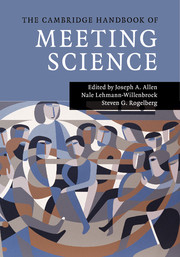Book contents
- The Cambridge Handbook of Meeting Science
- The Cambridge Handbook of Meeting Science
- Copyright page
- Dedication
- Contents
- Tables
- Figures
- Contributors
- Book part
- Part I Introduction
- Part II Premeeting Activities and Context
- Part III The Meeting Itself
- Capturing and Understanding Dynamics and Processes of the Meeting
- Tools and Models for Promoting Meeting Success
- 21 Designing and Executing Effective Meetings with Codified Best Facilitation Practices
- 22 Finding the Gorilla
- 23 Information Utilization in Meetings
- 24 What Is Consensus and How Is It Achieved in Meetings?
- 25 Creativity and Meetings
- Part IV Special Types of Meetings
- Part V Synthesis and Conclusion
- Book part
- Author Index
- Subject Index
- References
22 - Finding the Gorilla
The Impact of Complexity and Diversity on Meeting Process
from Tools and Models for Promoting Meeting Success
Published online by Cambridge University Press: 05 August 2015
- The Cambridge Handbook of Meeting Science
- The Cambridge Handbook of Meeting Science
- Copyright page
- Dedication
- Contents
- Tables
- Figures
- Contributors
- Book part
- Part I Introduction
- Part II Premeeting Activities and Context
- Part III The Meeting Itself
- Capturing and Understanding Dynamics and Processes of the Meeting
- Tools and Models for Promoting Meeting Success
- 21 Designing and Executing Effective Meetings with Codified Best Facilitation Practices
- 22 Finding the Gorilla
- 23 Information Utilization in Meetings
- 24 What Is Consensus and How Is It Achieved in Meetings?
- 25 Creativity and Meetings
- Part IV Special Types of Meetings
- Part V Synthesis and Conclusion
- Book part
- Author Index
- Subject Index
- References
Summary
Experienced leaders with decades of successfully leading organizations are much more likely today than in the past to make poor decisions or to be unceremoniously removed from their positions of authority. The underlying causes of these actions seem to be the failure to realize that complexity is the “new norm.” The new norm is responsible for subtle changes that are affecting meeting process, team composition, and the way problem solvers need to view the world as it grows more diverse. This chapter provides an understanding of the causes and impacts of complex systems on modern meeting planning. It introduces the concepts of a collective knowledge team (CKT) that uses diversities in a positive way to solve complex, nonlinear problems and of cognitive style theory as a powerful tool for managing team diversity and change. It also identifies 10 team task and work task competencies that appear to be crucial to team process success. Finally, it presents a complex meeting process model that incorporates complex theory, team and cognitive theory, critical skills and competencies, and the management of diversity and change into a meeting process model that, when used effectively, could increase success in modern-day problem solving.
- Type
- Chapter
- Information
- The Cambridge Handbook of Meeting Science , pp. 504 - 532Publisher: Cambridge University PressPrint publication year: 2015

